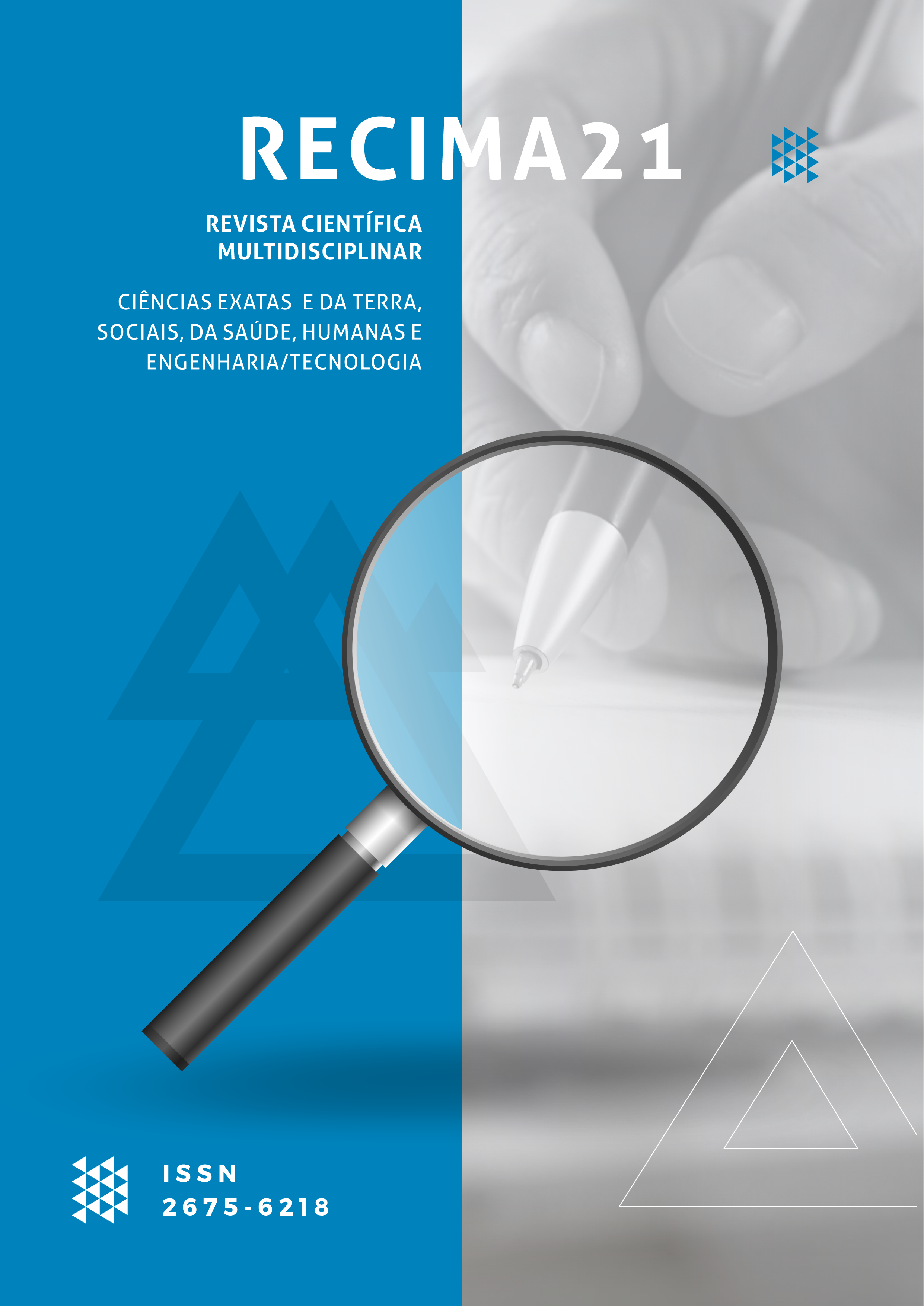PROFILE OF ORAL MICROBIOTA AND OBESITY IN ADOLESCENCE
DOI:
https://doi.org/10.47820/recima21.v3i3.1262Keywords:
Obesity, Gastrointestinal Microbiome, Adolescent.Abstract
Introduction: The World Health Organization (WHO) defines adolescence as the period between 10 and 19 years, 11 months and 29 days. Obesity in childhood and adolescence is associated with lifelong health maintenance and is a risk factor for obesity-associated diseases. Some studies have linked the oral microbiota with obesity in adolescents. Objective: To carry out a bibliographic survey about the oral microbiota and the correlation with obesity in adolescents. Methodology: This is a literature review that used the NCBI (PubMed), Scielo and Google Scholar platforms, the articles collected were in Portuguese and English. Data were collected from theses and articles, from the year 2008 to 2019. The research data were carried out by searching for the keywords: oral microbiota, adolescent, overweight. Results: The results point to a change in the profile of the oral microbiota in relation to obesity in adolescents. Conclusion: It is concluded that the microbiota plays a certain role in obesity in adolescents, despite this, there is a need for further studies on this topic.
Downloads
References
Obesidade e síndrome metabólica. ABESO, 2020. Disponível em: https://abeso.org.br/obesidade-esindromemetabolica/mapadaobesidade/#:~:text=Em%202025%2C%20a%20es timativa%20%C3%A9,19%2C8%25%20em%202018
ALVAREZ-LEITE, J. I. Nutrient deficiencies secondary to bariatric surgery. Current Opinion in Clinical Nutrition & Metabolic Care, v. 7, n. 5, p. 569-575, 2004. https://doi.org/10.1097/00075197-200409000-00010
APOVIAN, C. M. Obesity: definition, comorbidities, causes, and burden. Am J Manag Care, v. 22, n. 7 Suppl, p. s176-185, 2016
ARROYO-JOHNSON, C.; MINCEY, K. D. Obesity epidemiology worldwide. Gastroenterology Clinics, v. 45, n. 4, p. 571-579, 2016. https://doi.org/10.1016/j.gtc.2016.07.012
BRASIL. Ministério da Saúde. Pesquisa de Orçamentos Familiares 2008-2009. Antropometria e Estado Nutricional de Crianças, Adolescentes e Adultos no Brasil. Rio de Janeiro, RJ: IBGE, 2010.130p
CORREIA, S.; PERCEGONI, N. Microbiota intestinal e o ganho de peso corporal uma revisão. 1o Ciclo em Ciências da Nutrição. Juiz de Fora: Universidade Federal de Juiz de Fora. Repositório Aberto. 2014.
CRAIG S. J. C.; BLANKENBERG, D.; PARODI, A. C. L.; PAUL, I. M.; BIRCH, L. L.; SAVAGE, J. S.; MARINI, M. E.; STOKES, J. L.; NEKRUTENKO, A.; REIMHERR, M.; CHIAROMONTE, F.; MAKOVA, K. D. Child Weight Gain Trajectories Linked To Oral Microbiota Composition. Sci Rep. 2018; 8(1): 14030.
GUILHERME, R. P. A atividade física e a saúde oral em adultos com mais de 60 anos. Tese (Mestrado em Medicina Dentária) - Universidade Católica Portuguesa,
GOLDHABER-FIEBERT, J. D.; RUBINFELD, R.l E.; BHATTACHARYA, J.; ROBINSON, T. N.; WISE, P. H. The utility of childhood and adolescent obesity assessment in relation to adult health. Medical Decision Making, v. 33, n. 2, p. 163-175, 2013. https://doi.org/10.1177/0272989x12447240
HUTTENHOWER, C.; GEVERS, D.; KNIGHT, R.; ABUBUCKER, S.; BADGER, J.; CHINWALLA, A. Structure, function and diversity of the healthy human microbiome. Massachusetts: Nature International Journal of Science. v. 486, n. 14, p: 207–214, jun. 2012.
IANNUZZI, A.; LINCENZIATE, M. R.; ACAMPORA, C.; SALVATORE, V.; AURIEMMA, L.; ROMANO, M. L.; PANICO, S.; RUBBA, P.; TREVISAN, M. Increased carotid intima: media thickness and stiffness in obese children. Diabetes Care, v. 27, n. 10, p. 2506-8, 2004. https://doi.org/10.2337/diacare.27.10.2506
KONEMAN, E. Diagnóstico microbiológico: texto e atlas colorido. Rio de Janeiro: Guanabara Koogan, 2012. 6 ed, p.760-834.
LEY, R. E.; BACKHED, F.; TURNBAUGH, P.; LOZUPONE, C. A.; KNIGHT, R. D.; GORDON, J. I. Obesity alters gut microbial ecology. Proceedings of the National Academy of Sciences. v. 2, n. 31, p: 11070-11075, ago, 2005. https://doi.org/10.1073/pnas.0504978102
LAU, E.; MARQUES, C.; PESTANA, D.; SANTOALHA, M.; CARVALHO, D.; FREITAS, P. The role of I-FABP as a biomarker of intestinal barrier dysfunction driven by gut microbiota changes in obesity. Londe: Nutrition & Metabolism. v. 30, n. 13, p: 31. 2016. https://doi.org/10.1186/s12986-016-0089-7
MEDEIROS, C. C. M.; XAVIER, I. S.; SANTOS, V. E. F. A.; SOUZA, M. A. O.; VASCONCELOS, A. S.; ALVES, E. R. P. Obesidade infantil como fator de risco para a hipertensão arterial: uma revisão integrativa. Rev. Min. Enferm, V.1, p. 111- 119, 2012.
ORGANIZAÇÃO MUNDIAL DA SAÚDE (OMS). Grow reference 5-19 years. Body mass index for age (5-19 years), percentiles girls and boys, 2007. http://www.who.int/growthref/who2007_bmi_for age/en/index.html.
PISTELLI, G.; COSTA, C. Bactérias intestinais e obesidade. São Paulo: Revista Saúde e Pesquisa. v. 3, n. 1, p. 115-119. 2010.
RATHNAYAKE, N. ARKEMAN, S.; KLINGE, B.; LUNDEGREN, N.; JANSSON, H.; TRYSELIUS, Y.; SORSA, T.; GUSTAFSSON, A. Salivary biomarkers for detection of systemic diseases. PloS one, v. 8, n. 4, p. e61356, 2013. https://doi.org/10.1371/journal.pone.0061356
SILVA, S.; SANTOS, C.; BRESSAN, J. Intestinal microbiota; relevance to obesity and modulation by prebiotics and probiotics. Nutrición Hospitalaria. v. 28, n. 4, p: 48- 1039, aug. 2013. https://doi.org/10.3305/nh.2013.28.4.6525
VERDAM, F.; FUENTES, S.;JONGE, C.; ZOETENDAL, G.; ERBIL, R.; GREVE, W. Human intestinal microbiota composition is associated with local and systemic inflammation in obesity. Heerlen: The American Journal of Clinical Nutrition. v. 21, n. 12, p: 15-607, dez. 2013. https://doi.org/10.1002/oby.20466
ZHANG, Y.; WANG, X.; LI, H.; NI, C.; DU, Z.; YAN, F. Human oral microbiota and its modulation for oral health. Biomedicine & Pharmacotherapy. v.99, p.883–893, 2018. https://doi.org/10.1016/j.biopha.2018.01.146
YOON, A. J.; PHILIPONE, E.; CHENG, B.; TURNER, R.; LAMSTER, I. B. Inflammatory biomarkers in saliva: assessing the strength of association of diabetes mellitus and periodontal status with the oral inflammatory burden. Journal of clinical periodontology, v. 39, n. 5, p. 434-440, 2012. https://doi.org/10.1590/1807-3107bor-2019.vol33.0033
Downloads
Published
Issue
Section
Categories
License
Copyright (c) 2022 RECIMA21 - Revista Científica Multidisciplinar - ISSN 2675-6218

This work is licensed under a Creative Commons Attribution 4.0 International License.
Os direitos autorais dos artigos/resenhas/TCCs publicados pertecem à revista RECIMA21, e seguem o padrão Creative Commons (CC BY 4.0), permitindo a cópia ou reprodução, desde que cite a fonte e respeite os direitos dos autores e contenham menção aos mesmos nos créditos. Toda e qualquer obra publicada na revista, seu conteúdo é de responsabilidade dos autores, cabendo a RECIMA21 apenas ser o veículo de divulgação, seguindo os padrões nacionais e internacionais de publicação.













